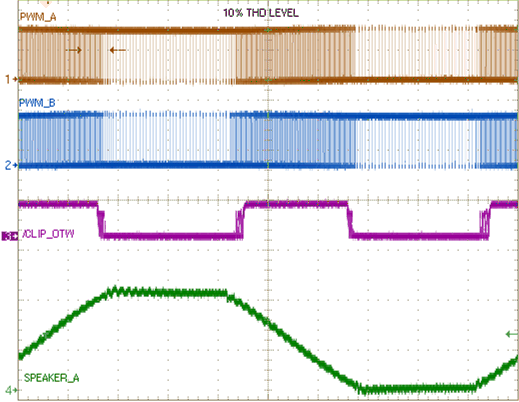SLASEM8A January 2019 – March 2019 TPA3255-Q1
PRODUCTION DATA.
- 1 Features
- 2 Applications
- 3 Description
- 4 Revision History
- 5 Pin Configuration and Functions
-
6 Specifications
- 6.1 Absolute Maximum Ratings
- 6.2 ESD Ratings
- 6.3 Recommended Operating Conditions
- 6.4 Thermal Information
- 6.5 Electrical Characteristics
- 6.6 Audio Characteristics (BTL)
- 6.7 Audio Characteristics (SE)
- 6.8 Audio Characteristics (PBTL)
- 6.9 Typical Characteristics, BTL Configuration
- 6.10 Typical Characteristics, SE Configuration
- 6.11 Typical Characteristics, PBTL Configuration
- 7 Parameter Measurement Information
-
8 Detailed Description
- 8.1 Overview
- 8.2 Functional Block Diagrams
- 8.3 Feature Description
- 8.4
Device Functional Modes
- 8.4.1
Device Protection System
- 8.4.1.1 Overload and Short Circuit Current Protection
- 8.4.1.2 Signal Clipping and Pulse Injector
- 8.4.1.3 DC Speaker Protection
- 8.4.1.4 Pin-to-Pin Short Circuit Protection (PPSC)
- 8.4.1.5 Overtemperature Protection OTW and OTE
- 8.4.1.6 Undervoltage Protection (UVP) and Power-on Reset (POR)
- 8.4.1.7 Fault Handling
- 8.4.1.8 Device Reset
- 8.4.1
Device Protection System
- 9 Application and Implementation
- 10Power Supply Recommendations
- 11Layout
- 12Device and Documentation Support
- 13Mechanical, Packaging, and Orderable Information
Package Options
Mechanical Data (Package|Pins)
- DDV|44
Thermal pad, mechanical data (Package|Pins)
- DDV|44
Orderable Information
8.4.1.2 Signal Clipping and Pulse Injector
A built in activity detector monitors the PWM activity of the OUT_X pins. TPA3255-Q1 is designed to drive unclipped output signals all the way to PVDD and GND rails. In case of audio signal clipping when applying excessive input signal voltage, or in case of CB3C current protection being active, the amplifier feedback loop of the audio channel will respond to this condition with a saturated state, and the output PWM signals would stop if the device did not have special circuitry implemented to handle this situation. To prevent the output PWM signals from stopping in a clipping or CB3C situation, narrow pulses are injected to the gate drive to maintain output activity. The injected narrow pulses are injected at every 4th PWM frame, and thus the effective switching frequency during this state is reduced to 1/4 of the normal switching frequency.
Signal clipping is signalled on the CLIP_OTW pin and is self clearing when signal level reduces and the device reverts to normal operation. The CLIP_OTW pulses start at the onset to output clipping, typically at a THD level around 0.01%, resulting in narrow CLIP_OTW pulses starting with a pulse width of ~500 ns.
 Figure 28. Signal Clipping PWM and Speaker Output Signals
Figure 28. Signal Clipping PWM and Speaker Output Signals